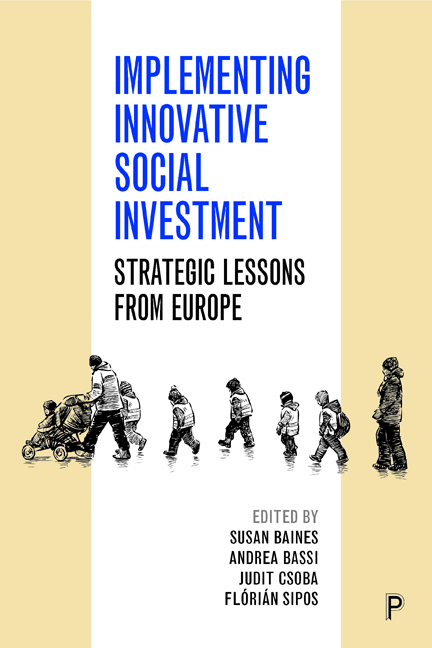Book contents
- Frontmatter
- Contents
- List of tables, figures, images and boxes
- Notes on contributors
- Acknowledgement
- one Social Investment in welfare: a sub-national perspective
- Part A Children and families: early intervention in people’s life courses
- Part B From a caring state to an investing state: labour market activation
- Part C Social solidarity and Social Investment
- Index
Part C - Social solidarity and Social Investment
Published online by Cambridge University Press: 21 April 2022
- Frontmatter
- Contents
- List of tables, figures, images and boxes
- Notes on contributors
- Acknowledgement
- one Social Investment in welfare: a sub-national perspective
- Part A Children and families: early intervention in people’s life courses
- Part B From a caring state to an investing state: labour market activation
- Part C Social solidarity and Social Investment
- Index
Summary
The third and last section of the book is dedicated to the question of how social solidarities are present in programmes based on Social Investment and innovation. Social solidarity is undoubtedly a key notion in all forms of social policies since the welfare state itself can be regarded as an institutionalised form of solidarity to cope with the risks of an industrialised society (Van der Veen, 2012), albeit that not all forms of social policy promote solidarity. Horizontal solidarity within local societies also deserves special attention since globalisation processes and the transformation of the welfare state also mean challenges to local communities.
According to Durkheim (1984), solidarity is an inherent obligation of people, a part of the collective consciousness, the social bond that connects individuals with each other in mutual responsibility – as opposed to the maximisation of personal gain described by liberal economists of the age to describe contractual relationships. Durkheim did not regard solidarity as an unchanged reality; he described a transformation of solidarities from that of traditional societies (mechanic solidarity between similar individuals sharing the same norms) to that of modern societies (organic solidarity between individuals with different but complementing positions in society).
Solidarity is not the same as charity, or, at least, is not necessarily the same. Some scholars even contrast the two notions by stressing that solidarity is (or should be) a horizontal relation existing between equals that does not humiliate those who receive transfers in a certain situation and is (or should be) based on rights, participation and access (Filcak and Skobla, 2012). Lack of solidarity decreases cohesion and the sense of trust and reciprocity, and gives way to segregation and a hierarchical or ‘us and them’ way of thinking. Solidarity protects society from disintegration and anomie, and is regarded as an effective way of improving the social environment and the real quality of life (Filcak and Skobla, 2012).
Fenger and Van Paridon (2012) used two dimensions to distinguish between types of solidarities: motive (morality and reciprocity) and level (individual and institutional). Individual solidarity is based on the decision of a single person, while institutional solidarity refers to forms that are organised according to formal or informal rules.
- Type
- Chapter
- Information
- Implementing Innovative Social InvestmentStrategic Lessons from Europe, pp. 143 - 146Publisher: Bristol University PressPrint publication year: 2019

